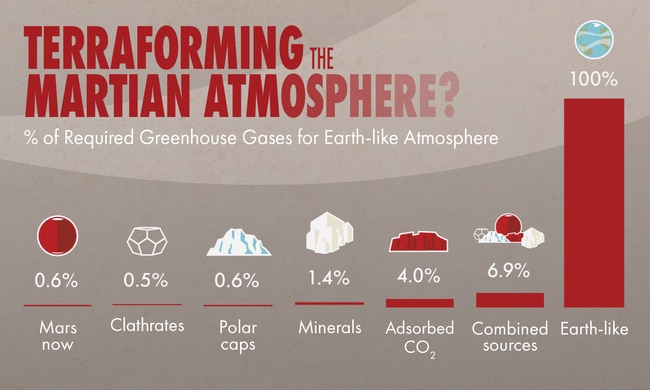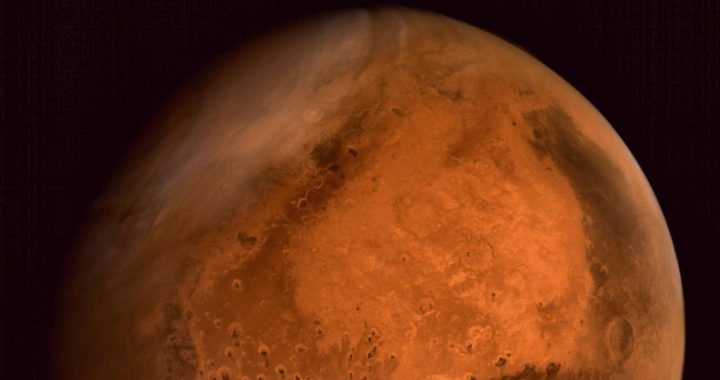Elon Musk said 2024, NASA says the 2030s, but colonising Mars could prove a much longer task.
NASA this week released a new study that said the idea of “terraforming” Mars was not possible using present day technology.
Some scientists had proposed flooding the Martian atmosphere with carbon dioxide from the planet to warm it up. It equates to creating the very greenhouse gas effect planet Earth is keen to avoid. But the study found that Mars didn’t have the resources to make this possible.
“However, Mars does not retain enough carbon dioxide that could practically be put back into the atmosphere to warm (it),” the study found.
Lead author of the study, Bruce Jakosky of the University of Colorado, said there was simply not enough CO2 on Mars to make this possible.
“Our results suggest that there is not enough CO2 remaining on Mars to provide significant greenhouse warming were the gas to be put into the atmosphere; in addition, most of the CO2 gas is not accessible and could not be readily mobilised,” he said. “As a result, terraforming Mars is not possible using present-day technology,” said Jakosky.
Terraforming Mars is one of the concepts proposed by Mr Musk. One method of releasing CO2 was to drop thermonuclear bombs over the poles.
Humans on Mars face many lethal hazards that all have to be overcome to survive there: solar and cosmic radiation; the atmosphere is toxic, there’s toxic dust on the planet and the low air pressure would see human blood boil at normal temperatures.
Some of these could be addressed with space suits, but there’s also low gravity. Another study said that under prolonged low gravity, humans would grow slightly taller but weaker. The movement of the brain upwards in the skull would impair the ability to think.

Discussion is focused on Mars with the Red Planet now its closest to Earth in 15 years, 58 million kilometres away. Over a 2-year orbit, Mars can be 400 million km away, about seven times the shortest distance, on the other side of the sun.
Travellers to Mars are therefore stuck there for two years, and with a return journey, their prolonged exposure to low and zero gravity poses another huge risk. The research suggests Mars will always be an inhospitable planet.
These difficulties are additional to finding and accessing sufficient water and making rocket fuel in space for travel.
Those aware of the complexities of building a colony on Mars are not necessarily convinced that it will be created in their lifetime.
“Realistically if I’m thinking about the habitat that we have created, I don’t think it will be in my lifetime, maybe the lifetime after me,” says Dana Mateluna, a young student from RMIT University in Melbourne who has been helping design a colony on Mars for one million people by 2030.
Students from RMIT University in Melbourne and Curtin University in Western Australia have been taking part in a global competition run by computer giant HP entitled “Mars Home Planet” to look at how to colonise the planet. The competition has attracted more than 85,000 participants globally.
The students from Curtin University have been designing a toolkit for Mars to be built with 3D printers. The RMIT University students have built an underground habitat for human inhabitants called a Nova Domus.
Ms Mateluna says going underground offers some hope of addressing survival. Their design includes a dome over the top of the habitat to protect the structure from radiation and wind. She describes it as a biosphere that would help control gravity.
“Mars’ gravity is less than here on earth, so if you’re there for a long time, you begin to get taller and lighter, and your bones begin to stretch and you feel a bit weak opening doors. You can get a heart attack.”
The local winner of the six-month competition is to be announced on August 9, the global winner on August 14.
HP also has been demonstrating a high resolution Mars’ virtual reality experience called Mars 2020 Game.
Using an HTC Vive VR headset, players experience setting off to Mars in a spaceship, tumbling towards the Martian surface and arriving, walking on Mars and driving a Mars buggy. The Mars 2030 game recreates some 40 square kilometres that has been mapped of the Martian surface and is available from computer games supplier Steam.
* Jason Crusan, who is in charge of developing the Mars mission at NASA, talks to Chris Griffith about the project in 2016. Listen here.
Chris Griffith appears Wednesdays at 6.30pm on TECH.biz, broadcast on Sky Business channel. Published in The Australian newspaper.
